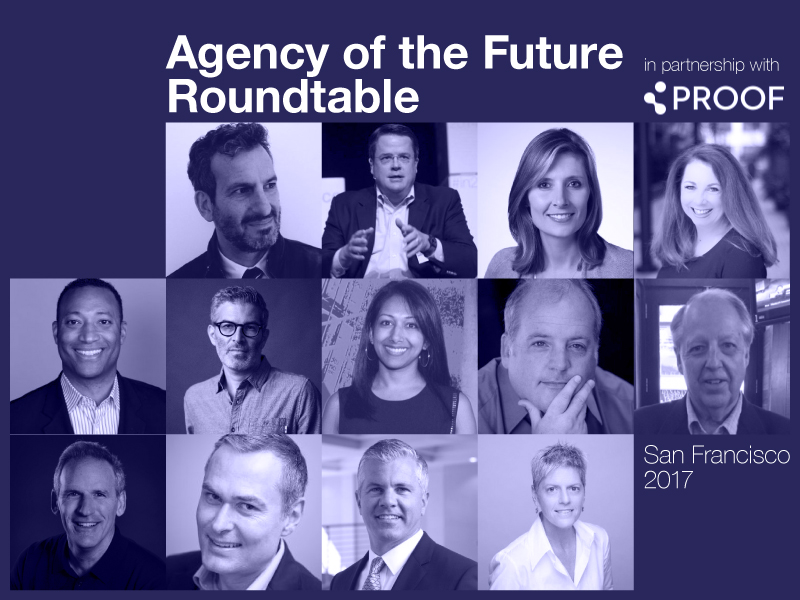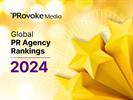Aarti Shah 31 Oct 2017 // 10:38PM GMT

The Agency of the Future nearly always piques the interest of both agency and brand-side decision makers as the continued convergence of marketing and PR has increasingly serious implications that ripple across the industry. But ultimately what defines ‘the future’ seems to vary, to some degree, by geography, practice and sector.
The Holmes Report, in partnership with Proof, brought together senior PR professionals in San Francisco to shine the spotlight on the critical issues facing the industry. The conversation spanned universal insights and, at times, filtered these issues through a U.S. West Coast lens. The main takeaway, however, was clear — business impact, diversity and expertise matters now, perhaps more than ever.
Participants:
Barbara Bates, CEO, Hotwire
Erik Petersen, Director, Globality
Luca Penati, President, Weber Sandwick West
Kelly McGinnis, CCO, Levis Strauss
Kim Hunter, CEO, LaGrant Foundation
Jackie Price, CEO, End Game Results
James Arnold, Senior Counselor, Gould & Company
Jason Schlossberg, Managing Director, Huge
Joe Carberry, SVP/Head of Communications, Charles Schwab
Jim Weiss, CEO, W2O Group
Mark Stouse, CEO, Proof
Scott Allison, CEO, Allison+Partners
Susan Butenhoff, CEO, Access

Defining and Delivering Business Value
The discussion began with a question around the macro-economic environment, in particular whether clients continue to be bullish despite some market uncertainty. Most participants agree that clients standards are higher than ever — and there’s increasing pressure on demonstrating results.
Proof CEO Mark Stouse said that “budgets are in many cases not coming down but the value extraction requirements are way up. People want a lot more for that money. The problem is that people define value differently, but it’s the business’ definition of value creation that is increasingly dominant. Their scrutiny of marketing and PR impact is intensifying. They want to see evidence that marketing, PR and their brand investments are monetizing. And if the economy softens significantly, that scrutiny will spike in a big, big way.”
Access Communications CEO Susan Butenhoff reinforced this by pointing out there’s more pressure on companies of all sizes, “it used to be that we’d say you get good, fast or cheap — you don’t get all three, you get to pick two. And the reality is, people now believe that you can get all three. And that’s what clients expect and they want us to be creative about delivering it.”
EndGame CEO Jackie Price added, “we’ve got almost 80% of boards and chief risk officers and CEOs saying they expect— in other words, they require — marketing, which includes PR, to contribute to growth. If you can show: ‘for every dollar you give me, I can get you two dollars in return,’ they’ll be lined up at the bank pulling dollar bills out. The question is, are you contributing to value?”
Stouse agreed. “Look, we’re seeing record numbers of CMOs losing their jobs right now. According to the CMO Council, the #1 reason is failure to show business impact. The definition of that business impact has been around for a long time – it’s all about marketing and PR’s incremental contribution to revenue, margin and cash flow. Marketing and PR exist to help companies sell more to more people, more profitably and faster, than those companies could if marketing and PR didn’t exist. Business leaders have wanted to drive accountability on these issues for years, and now they are doing it. The agency of the future, the marketing and PR professions of the future, will prioritize business impact as their North Star, and creative campaigns will be a crucial means to that end, not the end itself.”
"They want to see evidence that marketing, PR and their brand investments are monetizing. And if the economy softens significantly, that scrutiny will spike in a big, big way.”
LaGrant Foundation CEO Kim Hunter, meanwhile, cautioned that clients are streamlining their rosters via consolidation. “People are being squeezed from a consolidation perspective so while clients are asking for value – clients have always been asking for value – I’m not quite sure many of us have been delivering the value that we should be to justify our existence.”
Hotwire CEO Barbara Bates countered. “We’re seeing that companies are moving away from agencies of record. We’re not seeing budgets go down but they’re very fluid as to what they’re spending money on. We go back to the same thing: if you can show value the money is there.”
Stouse noted that he had recently spoken with a chief risk officer in Silicon Valley. The CRO was tasked by his board with examining the company’s total marketing spend. “They’re spending about $1.2 billion on total marketing expense, and their goal was to better understand the provable impact that marketing and PR deliver. They want to better manage their opportunity cost by better understanding the factors that diminish marketing’s business impact, like waste and digital ad fraud. What else could the company do with that money? How do we know that marketing and PR will spend the money entrusted to them in order to deliver maximum business impact and value?”
Charles Schwab SVP Joe Carberry argued against consolidation, noting the company spends more resources on non-media relations, while also expecting agencies to take a “360 view” and being more data-driven like marketing.
Levi Strauss CCO Kelly McGinnis said in previous roles she’s held, procurement was, not only, influential but also looked at PR through a marketing lens. “In a smaller company that’s going through a turn-around, expertise matters tremendously and that means subject matter expertise to the category that we’re operating in.”
She added, “It’s very hard to understand what’s the next generation thing that’s going to be the highest value return. The greatest value I’ve got out of an agency relationship in the last four years that I’ve been at Levis is my ability to have very frank conversations with our agency partners about budget. Those conversations are about budget and the fact that they must really honor the fact that I have what I have…The conversation that happens in my executive leadership team and my board is never about capabilities. It’s about the insight. So if we can identify an insight where there is white space, where there is opportunity — for either winning or losing — that’s what helps me figure out if I’m going to write the check.”
Hotwire CEO Bates said agencies are sometimes stretched between serving the strategic leads who put value on insight and the day-to-day contacts with other priorities on their to-do list.
But the group diverged on how to more specifically define value. For instance, Huge managing director Jason Schlossberg said at his firm most employees are “unified under this notion that we have to provide value to our customers’ users. It’s all about user-centered design, user-centered communications. I believe, maybe a little bit naively, that agencies get the clients they deserve in terms of how they go about their business, how they market themselves, how they provide value… I think that you can have a great insight as an agency or as a brand, but if you don’t have the capabilities to then bring that to life or execute against it, it doesn’t really do very much.”
Allison + Partners CEO Scott Allison spoke candidly that PR budgets are relatively flat, but the firm is seeing “a huge increase in our research and measurement budgets. Clients don’t just want to justify spend, they want to justify impact.”
When asked whether clients are willing to pay a premium for more sophisticated analytics, Allison said “they do…[But] to deliver what clients really want, then you need smart senior strategic people who are very expensive. Often you’re in a situation where clients don’t want to pay for that level of service. I think that’s the real struggle right now.”
Erik Petersen, director at Globality, says he’s seeing an “unprecedented” demand for faster time to value. “[Slow] is just insane in today’s world… Clients need content to fill their pipelines. They’ve got to fill their Snapchat, Twitter, Facebook, Instagram feeds. They don’t need 30 seconds, they need 30 hours of content for the same price. They need it to be integrated and consistent. So absolutely, the speed and velocity are critical, but you also have to deliver on all those other metrics and have those KPIs in place before you even begin.”
Weber Shandwick Western region president Luca Penati focused on identifying the problems the client is looking to solve. He also said the industry is facing a unprecedented competitive set. “We are not competing against each other around this table, we are competing with so many other things – with technology. Technology is going to define how people go to market.”
“I actually don’t think that expertise and experience are the same,” Levi’s CCO McGinnis said. “I think that it’s easy for those of us who’ve been here for decades to say ‘oh it takes a lot of experience to be able to assimilate all this information and identify an insight.’ But on a day-to-day basis I don’t think that’s what’s happening. I think expertise owns the room all the time and we shouldn’t overlook that.”
W2O CEO Jim Weiss recalled how he invested in analytics in 2009 when “I didn’t even know what it was. I had complete, blind faith in technology and analytics and now I have 500 to 600 analysts and data scientists.”
The conversation then shifted to the ways that agencies are differentiating and articulating their competitive set. Weber Shandwick’s Penati said diversifying points of entry with clients is transforming agency offerings. “You can have your communications client, but as soon as you go into the marketing team, you move to more project work that’s more content, digital and social by nature. We are changing as agency because the work is different to what we used to do 10 years ago.”
Weiss said today’s more competitive environment means “dumb and lazy doesn’t work anymore. A lot of folks used to get away with dumb and lazy…You know, we can sit here and talk about tech and machines and all this because it doesn’t matter. It’s going to happen, we’ll be ready for it.”
Proof CEO Stouse asked the group, why the big four consulting firms who — in many cases, operate on a similar model — are driving strong profits, experiencing substantial topline growth while also excelling on diversity. He also noted that these consulting firms are building large marketing and communications practices.
Access CEO Susan Butenhoff maintained the PR industry has “a different starting point. [The consulting firms] went into the game where communications was not considered to be the most valuable expense for a company, but instead the other services these consulting companies provided were and they set the benchmark…[But consulting firms] are not going to be perfect for every client. They’re great for big engagements, usually where they already have a footprint. Their digital business is growing because they are giving it away and their profits are growing because they are being funded by the other smart consultants…I think it’s good because it lights a fire under us but I don’t want us to feel like we can only compete when we become mini consultancies.”
Yet Stouse pointed out that among these services is change management — something PR firms increasingly provide — yet, management consultancies command significantly higher rates for that service.
"Don’t tell me how to write a better press release, don’t tell me how to write a better CEO memo, tell me how my function can add business value.”“It’s history, it’s their billing rate,” Butenhoff noted. “This is a big $13bn market — what percentage of that is going to Deloitte? Next time I’m pitching a $5million, $10million piece of business, maybe they’ll be in the room. But there are a lot of other clients where we can do meaningful work.”
The talk about management consultancies prompted the group to consider the intellectual heft of the talent coming into PR. EndGame’s Price argued the industry doesn’t promote business acumen and does itself a disservice by believing that insights are expensive.
“It’s not the insight itself is expensive but smart people are expensive,” Allison rebuted. “That was my point.”
“I think you can also say here that not having the insights, the intelligence, the understanding, is the truly expensive part,” Stouse said. “Look at companies like Kodak. Why did they lose their franchise, their market leadership? In the end, it was because they didn’t want to know what they desperately needed to know in order to change and win.”
Carberry pointed out the “central opportunity” for the industry is dig into business literacy because “if you sit in my chair or [Kelly McGinnis’ chair], you’re not having conversations about communications. Don’t tell me how to write a better press release, don’t tell me how to write a better CEO memo, tell me how my function can add business value.”
Huge’s Schlossberg took the conversation back to integration — and ultimately “the agency of the future will understand business value and solving problems. But those insights are always agnostic, they’re not tied to a particular tactic or discipline.”
Gould & Partner’s James Arnold added, “I believe you have insights and then the data supports it or doesn’t support it — but data does not suddenly create a full blown solution. Agencies need more people who can look at the data and say here’s the plan, here is the strategy.”
McGinnis simply defined insight as “something I don’t know. To me that’s where the insight is, is bringing something forward that doesn’t reinforce the intuition that you already have.”
Next Generation and Diversity
Has the industry accommodated new profiles of talent — those who are more business-oriented, data savvy or trained to glean insights? Price says she’s seen many next-generation superstars eschew the daily grind of office work for more flexibility.
“Because of our size, we get a lot of people who are looking to get out of the big holding companies,” said Hotwire’s Bates. “I don’t really care where they sit. We have a results oriented work environment. We don’t require our staff to come into the office every day. They need to be where the work needs to get done and it’s amazing, that little change opens up a whole different type of recruiting.”
According to the Holmes Report’s Best Agency to Work For research, 57% of PR professionals believe their compensation is competitive and their jobs are financially rewarding. Meanwhile, on the diversity front, General Mills and HP now require their agency teams to demonstrate diversity. The group was asked about diversity initiatives that were implemented within their organizations.
"If you delegate that hiring down in the organization they’re going to look at very different type of candidate."I worked at an HP agency and when [CMO] Antonio Lucio set those diversity parameters," said Globality’s Petersen said. “I sat with the head of HR, this was a holding company, and we put together a plan, office by office. We went out and recruited and said this is our mandate and brought people in to interview that were going to help us to meet those specific goals.”
I think you’ve got to go a layer deeper,” Allison added. “I speak at a lot of colleges around the country — and in the PR, comms classes, the student profile is 90% white, Caucasian females. So we have to go a layer deeper to really get high school students encouraged to participate in communications.”
LaGrant Foundation CEO Hunter, who founded the non-profit in 1998 to address the lack of diversity in the marketing and PR sectors, said “I’m still amazed we are still having this conversation about [diversity and inclusion].” He called for going beyond hiring entry level candidates, but instead hiring diverse candidates at the mid-to-senior levels. For instance, Weber Shandwick hired the former dean of the Scripps Howard School of Journalism as an EVP — even though he didn’t have agency experience.
“The CEOs get it — but the tragedy happens when it drops down to the HR people,” Hunter said. “And I’m telling you, if you really want to change, take risks. But I’m just not seeing leadership on D&I, I don’t see people making commitments…and if you can’t find diverse candidates, my question is — where are you looking?”
Hotwire’s Bates agreed that agency CEOs need to be “incredibly involved in recruiting because, it’s not even just about race or gender, it’s about background. I don’t really hire that many communications graduates or PR graduates. We look for critical thinkers and you’re going to get those folks in a lot of different educational backgrounds or even experiences. But if you delegate that hiring down in the organization they’re going to look at very different type of candidate.”
Mark Stouse added that diversity “we’re talking about sustainability and harnessing diversity of thought and life experience into something that delivers sustainable value for clients, for agencies, for the business models that exists on both. I think that’s one of the genius parts about the way that Accenture and EY handled this issue because they clearly set their expectations on diversity. Now, when you walk into an Accenture or EY office, you see physical and intellectual diversity on an epic scale. There’s no reason why you shouldn’t see it in PR or in marketing agencies.”
“I would argue that at the team level, you get a tremendous amount of push back if your team looks like a monoculture,” Levi’s McGinnis said. “So having a team that’s a little too white and a little too female, we have a reputation for being a sorority. How do you break that up? There’s a very active conversation holding each other accountable and holding our hiring managers accountable for not perpetuating that. It’s hard but I wouldn’t say it’s only top down at all.”
Huge’s Schlossberg pointed out the role of implicit bias when senior managers say they are looking “really smart people” because the outcome is limited to their definition of smart, often resulting in a homogenous organization.
Stouse says diversity gives “a hedge of protection” against “a catastrophic error” by the team. “It was so important that my direct reports at HP, BMC and Honeywell were not like me. We pursued that outcome intentionally and with vigor. The whole goal was to deliver a highly synergistic team that could drive a greater level of impact than any one person or small group could create by themselves.”
“That’s the crux of it,” said Butenhoff. “If you have a diversity hiring plan because you’re seeing all the RFPs coming in requiring that, it’s almost a shallow view of it, like I’ve got to check off the box versus really understanding it by bringing in diverse thinkers.”
The Future of Compensation
When it comes to equal pay, Allison said pay equity has been “a big centerpiece for us and we went through person by person, office by office for gender pay equality. We made sure that there was no discrepancy.”
Similarly, Butenhoff said they’ve done the same exercise for a health-check and if disparity is found, the pay is increased in real-time. “It’s built into our budget,” she said.
The group also talked about migrating talent from pricey American coastal cities to other parts of the country. “It’s slightly controversial and my team was very resistant when we first started talking about it, but we go for the cow sourcing model,” McGinnis said. “We go for really smart people who are in the middle of the country at lower costs of living…The value equation goes up really fast when people are grateful for the work instead of thinking they’re doing you a favor.”
Carberry echoed this, noting that the vast majority of the company’s workforce live in markets outside of New York, San Francisco and Los Angeles. “We have a long-term geographic strategy that has put most our people in Denver, Phoenix, Orland and Indianapolis. The majority of my team isn’t in San Francisco or New York.”
“We’re focusing on Portland, Salt Lake and a few other cities as well,” noted W2O’s Weiss.
Penati countered: ”But we can’t forget that there is magic when you have creative people in the room working together particularly when the complexity of what we do is getting more and more enhanced.”
On the subject of talent costs, the conversation shifted to whether acquiring new business is more expensive than before — essentially forcing agencies to start new business relationship with a built-in “revenue acquisition debt.”
“I think it’s again hard to make these broad generalizations,” Allison said. “But we are seeing the cost of acquiring big consumer clients going through the roof. But we find the cost for winning technology clients [relatively small].”
“And [consumer brands] take so long,” Butenhoff added. “I think the consumer big brands are getting super challenging.”



































.jpg)
































